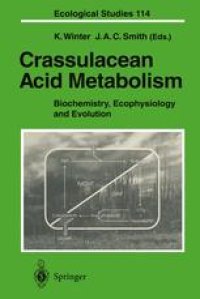
Ebook: Crassulacean Acid Metabolism: Biochemistry, Ecophysiology and Evolution
- Genre: Biology // Biochemistry
- Tags: Plant Sciences, Geoecology/Natural Processes, Nature Conservation, Ecology, Agriculture, Forestry
- Series: Ecological Studies 114
- Year: 1996
- Publisher: Springer-Verlag Berlin Heidelberg
- Edition: 1
- Language: English
- pdf
Crassulacean acid metabolism (CAM) represents one of the best-studied metabolic examples of an ecological adaptation to environmental stress. Well over 5 % of all vascular plant species engage in this water-conserving photosynthetic pathway. Intensified research activities over the last 10 years have led to major advances in understanding the biology of CAM plants.
New areas of research reviewed in detail in this book include regulation of gene expression and the molecular basis of CAM, the ecophysiology of CAM plants from tropical environments, the productivity of agronomically important cacti and agaves, the ecophysiology of CAM in submerged aquatic plants, and the taxonomic diversity and evolutionary origins of CAM.
Crassulacean acid metabolism (CAM) represents one of the best-studied metabolic examples of an ecological adaptation to environmental stress. Well over 5 % of all vascular plant species engage in this water-conserving photosynthetic pathway. Intensified research activities over the last 10 years have led to major advances in understanding the biology of CAM plants.
New areas of research reviewed in detail in this book include regulation of gene expression and the molecular basis of CAM, the ecophysiology of CAM plants from tropical environments, the productivity of agronomically important cacti and agaves, the ecophysiology of CAM in submerged aquatic plants, and the taxonomic diversity and evolutionary origins of CAM.
Crassulacean acid metabolism (CAM) represents one of the best-studied metabolic examples of an ecological adaptation to environmental stress. Well over 5 % of all vascular plant species engage in this water-conserving photosynthetic pathway. Intensified research activities over the last 10 years have led to major advances in understanding the biology of CAM plants.
New areas of research reviewed in detail in this book include regulation of gene expression and the molecular basis of CAM, the ecophysiology of CAM plants from tropical environments, the productivity of agronomically important cacti and agaves, the ecophysiology of CAM in submerged aquatic plants, and the taxonomic diversity and evolutionary origins of CAM.
Content:
Front Matter....Pages I-XXXII
An Introduction to Crassulacean Acid Metabolism. Biochemical Principles and Ecological Diversity....Pages 1-13
Front Matter....Pages 15-18
Stoichiometric Nightmares: Studies of Photosynthetic O2 and CO2 Exchanges in CAM Plants....Pages 19-30
Alternative Carbohydrate Reserves Used in the Daily Cycle of Crassulacean Acid Metabolism....Pages 31-45
Roles of Circadian Rhythms, Light and Temperature in the Regulation of Phosphoenolpyruvate Carboxylase in Crassulacean Acid Metabolism....Pages 46-52
Transport Across the Vacuolar Membrane in CAM Plants....Pages 53-71
The Tonoplast as a Target of Temperature Effects in Crassulacean Acid Metabolism....Pages 72-77
Regulation of Crassulacean Acid Metabolism in Kalanchoe pinnata as Studied by Gas Exchange and Measurements of Chlorophyll Fluorescence....Pages 78-96
Energy Dissipation and the Xanthophyll Cycle in CAM Plants....Pages 97-114
Front Matter....Pages 115-118
Transcriptional Activation of CAM Genes During Development and Environmental Stress....Pages 119-134
Environmental Control of CAM Induction in Mesembryanthemum crystallinum - a Role for Cytokinin, Abscisic Acid and Jasmonate?....Pages 135-158
Putative Causes and Consequences of Recycling CO2 via Crassulacean Acid Metabolism....Pages 159-175
Variations in the Phases of Crassulacean Acid Metabolism and Regulation of Carboxylation Patterns Determined by Carbon-Isotope-Discrimination Techniques....Pages 176-191
Front Matter....Pages 192-203
High Productivity of Certain Agronomic CAM Species....Pages 204-215
Features of Roots of CAM Plants....Pages 216-229
Aquatic CAM Photosynthesis....Pages 230-249
Front Matter....Pages 251-254
Seasonal Changes in Daytime Versus Nighttime CO2 Fixation of Clusia uvitana In Situ....Pages 255-265
Crassulacean Acid Metabolism in the Genus Kalanchoe: Ecological, Physiological and Biochemical Aspects....Pages 266-280
Carbon- and Hydrogen-Isotope Discrimination in Crassulacean Acid Metabolism....Pages 281-295
Evolutionary Aspects of Crassulacean Acid Metabolism in the Crassulaceae....Pages 296-311
The Evolution of Crassulacean Acid Metabolism....Pages 251-254
Front Matter....Pages 312-323
Crassulacean Acid Metabolism: Current Status and Perspectives....Pages 324-335
Taxonomic Distribution of Crassulacean Acid Metabolism....Pages 336-348
Back Matter....Pages 349-359
....Pages 360-385
Download the book Crassulacean Acid Metabolism: Biochemistry, Ecophysiology and Evolution for free or read online
Continue reading on any device:

Last viewed books
Related books
{related-news}
Comments (0)